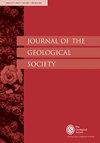吐哈盆地胜北次凹陷中侏罗统七克台组二段湖相页岩有机质富集与古沉积环境重建
IF 3
3区 地球科学
Q2 GEOSCIENCES, MULTIDISCIPLINARY
引用次数: 0
摘要
吐哈盆地胜北次凹陷侏罗系七克台组二段(j2q2)湖相富有机质页岩由于沉积环境的频繁变化,表现出较强的非均质性。j2q2上、下单元的页岩环境差异明显,为研究复杂沉积背景下有机质富集机制提供了理想的范例。通过岩石学、矿物学、主微量元素和同位素分析,重建了古环境,揭示了OM的富集机制。结果表明,j2q2页岩沉积环境为湖相碳酸盐-硅屑混合环境,古环境指标为缺氧-缺氧、轻度微咸水环境。通过对j2q2段和j2q2段的综合对比,建立了有机质富集模型,阐明了富有机质页岩形成的主控因素。在暖湿气候背景下,j2 q2下部单元沉积在较深、受限制较大的水体中,化学风化作用较强,陆源输入相对上部单元有限。无机地球化学分析表明,j2q2下部单元初级生产力较高,但存在局部波动。较高的初级生产力和良好的保存条件决定了研究区有机质的富集。补充资料:https://doi.org/10.6084/m9.figshare.c.6901480本文章由计算机程序翻译,如有差异,请以英文原文为准。
Organic matter enrichment and paleo-sedimentary environment reconstruction of lacustrine shale in the second member of the Middle Jurassic Qiketai Formation in Shengbei Sub-sag, Turpan-Hami Basin, northwest China
Lacustrine organic-rich shales in the second member of the Jurassic Qiketai Formation (J 2 q 2 ) in the Shengbei Sub-sag, Turpan-Hami basin, northwest China exhibit strong heterogeneity due to frequent alternations of sedimentary environments. The distinct shale environments present in both upper and lower units of J 2 q 2 provide an ideal example for studying the enrichment mechanism of organic matter (OM) under a complex sedimentary background. In this study, petrological, mineralogical, major/trace element, and isotopic analyses were used to reconstruct the paleo-environment and reveal the mechanisms of OM enrichment. The results indicate that the J 2 q 2 shale was deposited in a lacustrine mixed carbonate-siliciclastic environment and the paleo-environment indicators suggesting an oxic-dysoxic, mildly brackish water condition. Based on a comprehensive comparison of both members of J 2 q 2 , an OM enrichment model was established and the main controlling factor of the formation of the organic-rich shale is elucidated. Under the background of a warm-humid climate, the lower unit of J 2 q 2 was deposited in a deeper and more restricted water body with stronger chemical weathering, resulting in limited terrestrial input compared to that of the upper unit. The inorganic geochemical analysis indicates a higher primary productivity in the lower unit of J 2 q 2 with local fluctuations. High primary productivity and favorable preservation conditions domain the OM enrichment in the study area. Supplementary material: https://doi.org/10.6084/m9.figshare.c.6901480
求助全文
通过发布文献求助,成功后即可免费获取论文全文。
去求助
来源期刊

Journal of the Geological Society
地学-地球科学综合
CiteScore
6.00
自引率
3.70%
发文量
68
审稿时长
6-12 weeks
期刊介绍:
Journal of the Geological Society (JGS) is owned and published by the Geological Society of London.
JGS publishes topical, high-quality recent research across the full range of Earth Sciences. Papers are interdisciplinary in nature and emphasize the development of an understanding of fundamental geological processes. Broad interest articles that refer to regional studies, but which extend beyond their geographical context are also welcomed.
Each year JGS presents the ‘JGS Early Career Award'' for papers published in the journal, which rewards the writing of well-written, exciting papers from early career geologists.
The journal publishes research and invited review articles, discussion papers and thematic sets.
 求助内容:
求助内容: 应助结果提醒方式:
应助结果提醒方式:


